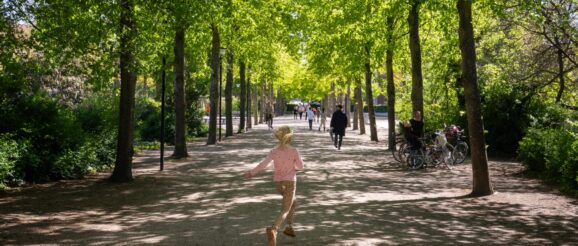Climate change is threatening Copenhagen, but the city has a plan

COPENHAGEN, Denmark — Sometimes, a single storm can change a city. For Copenhagen, that storm hit on July 2, 2011.
“It was over 100 millimeters of rain in a couple of hours. It fell directly on the city of Copenhagen,” recalls Mark Payne, a climate researcher at the Danish Meteorological Institute.

Martin Lehmann/Polfoto via AP
Sewers overflowed, and the streets filled with raw sewage, causing more than $1 billion in damage to property. Video from the weather event shows city streets transformed into waterways and passing city buses generating waves that broke against storefronts, while the rain persisted, relentless and torrential.

Climate scientists like Payne call these storms “cloudbursts,” or extreme rain events. As the planet warms, the atmosphere can hold more moisture, which can lead to more intense rainfall events.

“The typical rule of thumb is that for 1 degree Celsius of warming, the atmosphere holds 7% more water,” Payne says.
Europe is the fastest-warming continent, according to scientists from the United Nations and the European Environment Agency. Temperatures are increasing at twice the global average rate, leading to more fires and flooding.

That means cities built centuries ago are racing to adapt.
In Copenhagen, meteorologists predict the city will receive 30% more rainfall by the end of this century. Just a year after the flood, city officials adopted a “Cloudburst Management Plan,” a $1.3 billion public works project to complete 300 flood-mitigation projects over two decades.

Tunnels beneath the city

To show it off, engineer Jes Clauson-Kaas carefully descends down nine stories of rickety scaffolding along the edge of a massive concrete hole bored into the earth.
When he arrives at the bottom, he lifts his head and brings two fingers to his lips to produce a loud whistle, its screech echoing along the curved concrete walls above.
“An opera singer’s dream,” he says, smiling.

Collecting rain in “sponge parks”
Just blocks away from the Kalvebod Brygge tunnel is Enghaveparken, a century-old park that was redesigned after the 2011 flood to transform into a massive reservoir in the event of heavy rain.

Today, neighborhood children play on a soccer field carved deep into the ground. The park itself is enclosed by a 3-foot-high concrete wall with gates that automatically emerge from the ground, sealing the park so that it can hold floodwater.
Storing rainwater on the surface makes more sense than expanding the sewer system, says Jan Rasmussen, director of climate adaptation for the city of Copenhagen.
“You can’t expand a pipe as easily as this area can be expanded,” he says. “[It’s] also much cheaper if we can use areas like this to store rainwater.”
Rasmussen says Copenhagen has transformed 20 green areas like Enghaveparken into what the city nicknames “sponge parks.” When full, he says, Enghaveparken can hold 25,000 cubic meters of water. When it’s not raining, a 2,000-cubic-meter storage tank underneath a rose garden in the park holds rainwater collected from the neighborhood’s storm drains, used to irrigate the park’s lawns, trees and flowers.


In addition to the sponge parks and cloudburst tunnels, Copenhagen has also just broken ground on a human-made island off its coast, named Lynetteholm. The island will house 35,000 people and protect the city against storm surges, another weather phenomenon happening more often here as the climate warms and sea levels rise. The island is expected to be finished by 2070.
The scale of the city’s long-term climate adaptation planning has gained admirers among urban planners throughout the world, says Rasmussen. In addition to penning a collaboration with New York City on climate adaptation, he says, Copenhagen has also consulted with cities in South Africa, China, Germany and beyond on how they can build similar infrastructure to mitigate the increased flooding that comes with climate change.
“The trick to make all of this a success,” says Rasmussen, “is intense planning.”

Esme Nicholson contributed reporting to this piece from Berlin. Edited by Rachel Waldholz
